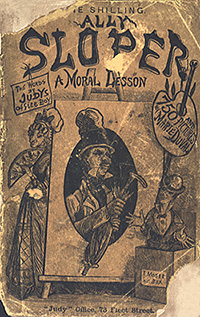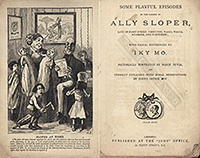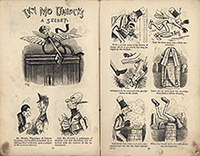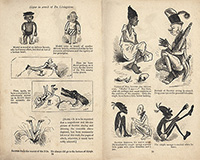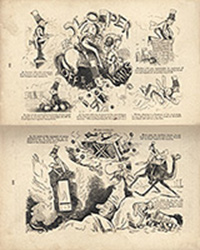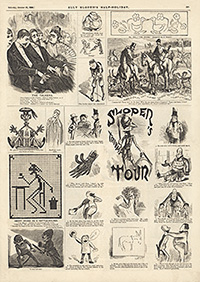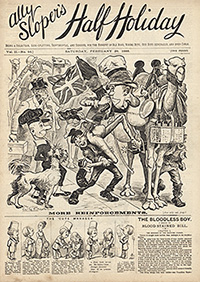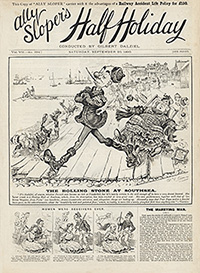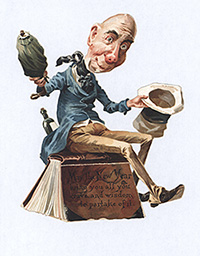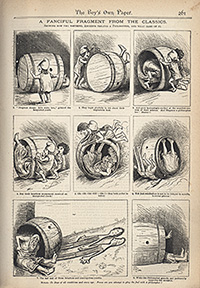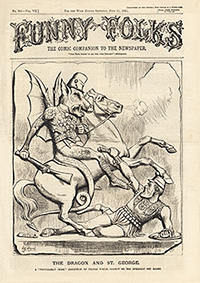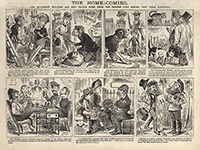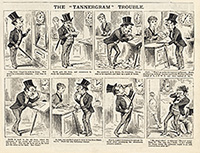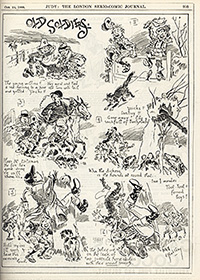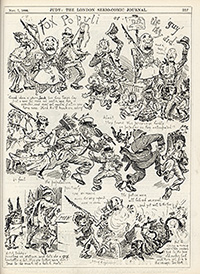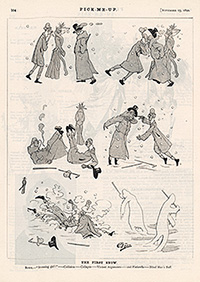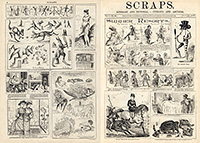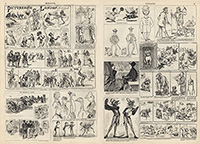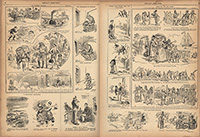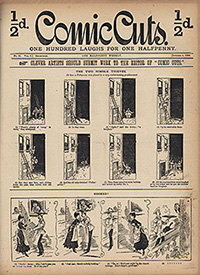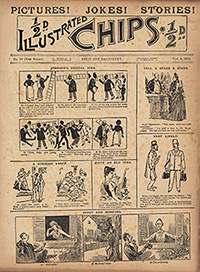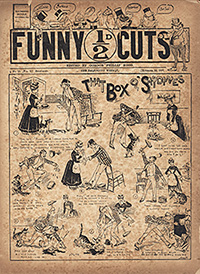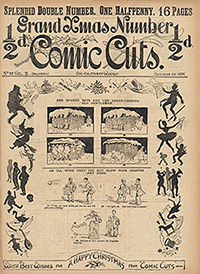Exhibit A1
[Ross, Charles H.]. Some Playful Episodes in the Career of Ally Sloper. Illustrated by Marie Duval. London: “Judy” Office. [1873].
The first collection of Ally Sloper strips, originally published in November 1873, more
Exhibit A2
[Ross, Charles H.]. Some Playful Episodes in the Career of Ally Sloper. Illustrated by Marie Duval. London: “Judy” Office. [1873].
The full title-page playfully conceals the author’s name behind the phrase “Judy’s office boy”, but gives full credit to Marie Duval, nom d’artiste of Emily Louisa Tessier, more
Exhibit A3
[Ross, Charles H.]. Some Playful Episodes in the Career of Ally Sloper. Illustrated by Marie Duval. London: “Judy” Office. [1873].
In a number of the earlier strips, Ally Sloper is partnered with a smooth and quick-witted Jewish character, more
Exhibit A4
[Ross, Charles H.]. Some Playful Episodes in the Career of Ally Sloper. Illustrated by Marie Duval. London: “Judy” Office. [1873].
Two pages extracted from a nine-page strip, “Sloper in Search of Dr. Livingstone”, more
Exhibit A5
[Ross, Charles H.]. Some Playful Episodes in the Career of Ally Sloper. Illustrated by Marie Duval. London: “Judy” Office. [1873].
“Ally Sloper Off to the Wars”, a dream sequence in which Ally Sloper imagines his brave actions as a Special Correspondent in the Franco-Prussian War, more
Exhibit A6
Ally Sloper’s Half-Holiday. London: W. J. Sinkins [for Gilbert Dalziel].[Vol.1], no. 26. 25 October 1884.
In 1884, after buying the rights to Ally Sloper from Charles Ross, Gilbert Dalziel devised a comic paper to feature his new purchase, calling it Ally Sloper’s Half-Holiday. more
Exhibit A7
Ally Sloper’s Half-Holiday. London: W. J. Sinkins [for Gilbert Dalziel]. Vol. 2, no. 44. 28 February 1885.
In the new weekly, Ally Sloper’s Half-Holiday, Ally Sloper was transformed into a carefully drawn, satirical character, more
Exhibit A8
Ally Sloper’s Half-Holiday. London: Gilbert Dalziel. Vol. 7, no. 334. 20 September 1890.
Ally Sloper’s latest get-rich-quick scheme: a roller-skating rink at the coastal resort of Southsea. William Fletcher Thomas has now taken over the task of drawing Sloper, more
Exhibit A9
Stereoview card. “Ally Sloper Run In”. No. 1728. [c.1890].
This stereoview card depicts Ally Sloper (wearing a pantomime-style mask) being arrested at the rear of a house. more
Exhibit A10
New Year Card. Ally Sloper. [c.1890].
On this die-cut greeting card (which has a small repair to Sloper’s head), Ally Sloper is seated on a leather-bound book, more
Exhibit A11
The Boys’ Own Paper. London: “Leisure Hour” Office [Religious Tract Society]. Vol. 2, no. 54. 24 January 1880.
Pirated from German artist Wilhelm Busch, this eight-panel picture story, here called “A Fanciful Fragment from the Classics”, more
Exhibit A12
Funny Folks. London: James Henderson.Vol. 7, no. 341. 11 June 1881.
As a weekly “comic paper” containing relatively few comic strips, Funny Folks (1874–94) constitutes an important link between late-Victorian comic magazines and the fully-fledged comics of the 1890s. more
Exhibit A13
Funny Folks. London: James Henderson. Vol. 11, no. 567. 10 October 1885.
At first sight this may look like a continuous comic strip, but it is actually a series of separate pictures illustrating a series of separate homecomings. more
Exhibit A14
Funny Folks. London: James Henderson.Vol. 11, no. 568. 17 October 1885.
A true comic strip has to tell a story. Here, a man is so confused by new Post Office forms that he accidentally sends a telegram to himself more
Exhibit A15
Judy: The London Serio-Comic Journal. London: “Judy” Office at 99 Shoe Lane. Vol. 43 (issue not numbered).
7 November 1888.
“Old Soldiers”, an early full-page urchin strip by Alfred Gray, one of the pioneering British comics artists. Alfred Gray also had material published in Pick-Me-Up, more
Exhibit A16
Judy: The London Serio-Comic Journal. London: “Judy” Office at 99 Shoe Lane. Vol. 43 (issue not numbered). 7 November 1888.
“Fox Populi”, a full-page topical strip by Alfred Gray, published in the issue of Judy available just before Guy Fawkes Night, 5 November 1888. more
Exhibit A17
Pick-Me-Up. London: 11 Southampton Buildings. Vol. 5, no. 111. 15 November 1890.
“The First Snow”, signed “Döes” (French cartoonist Louis-Christian Döes), probably pinched from Le Rire. In occasional announcements cheekily entitled “Things Pick’d Up”, more
Exhibit A18
Scraps. London: James Henderson. Vol. 1, no. 46. 12 July 1884.
The front and back pages of an early issue of Scraps (“Literary and Pictorial – Curious and Amusing”), which also borrowed heavily from American, French and German sources. more
Exhibit A19
Scraps. London: James Henderson. Vol. 1, no. 46. 12 July 1884.
The centre pages of Scraps (pages 4 and 5) are strikingly similar to the centre-page spread of later British comics, but as opposed to post-1890 comics, more
Exhibit A20
Snap-Shots. London: James Henderson. Vol. 1, no. 1. 9 August 1890.
A typical Snap-Shots double-page spread. Publisher James Henderson characterized his comic paper as an assembly of “Humorous Pictures and Amusing Reading. more
Exhibit A21
Comic Cuts. [London]: “Answers” Company [Alfred Harmsworth]. Vol. 1, no. 21. 4 October 1890.
An early number of Alfred Harmsworth’s first venture in the comics field, which he called Comic Cuts (“cut” being printer’s jargon for an engraving on a printing block). more
Exhibit A22
Illustrated Chips. [London]: “Answers” Company [Alfred Harmsworth]. No. 10 (new series). 8 November 1890.
Illustrated Chips, Alfred Harmsworth’s companion comic to Comic Cuts, was widely known simply as Chips (“chip” being printer’s jargon for a short text or an illustration used as a space filler). more
Exhibit A23
Funny Cuts. [London]: Trapps Holmes & Co. Vol. 1, no. 20. 22 November 1890.
Edited by Gordon Phillip Hood, Funny Cuts was another new halfpenny comic. By 1891, the publisher was proclaiming that “Funny Cuts has the largest circulation in the world of any Funny Paper” more
Exhibit A24
Comic Cuts Grand Xmas Number. [London]: “Answers” Company [Alfred Harmsworth]. Vol. 2, no. 32. 20 December 1890.
An early example of what was to become a tradition in British comics: the special Christmas number. more
